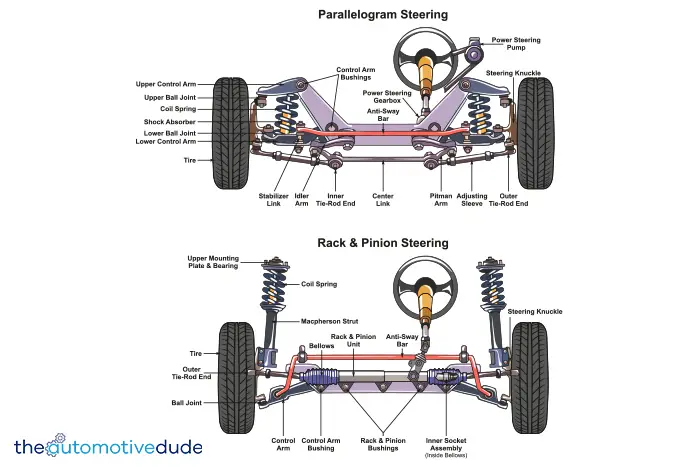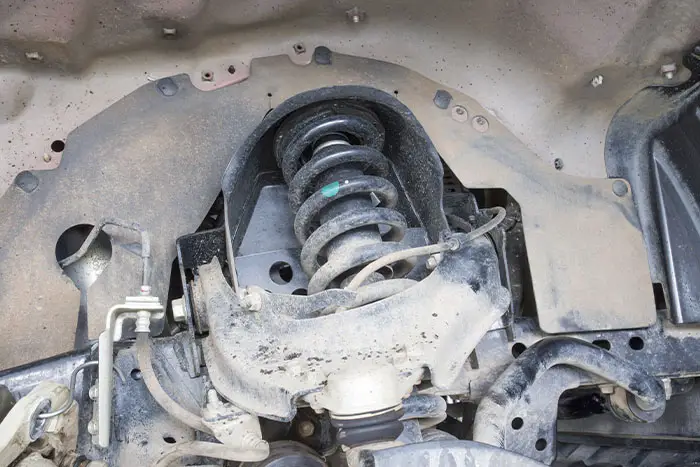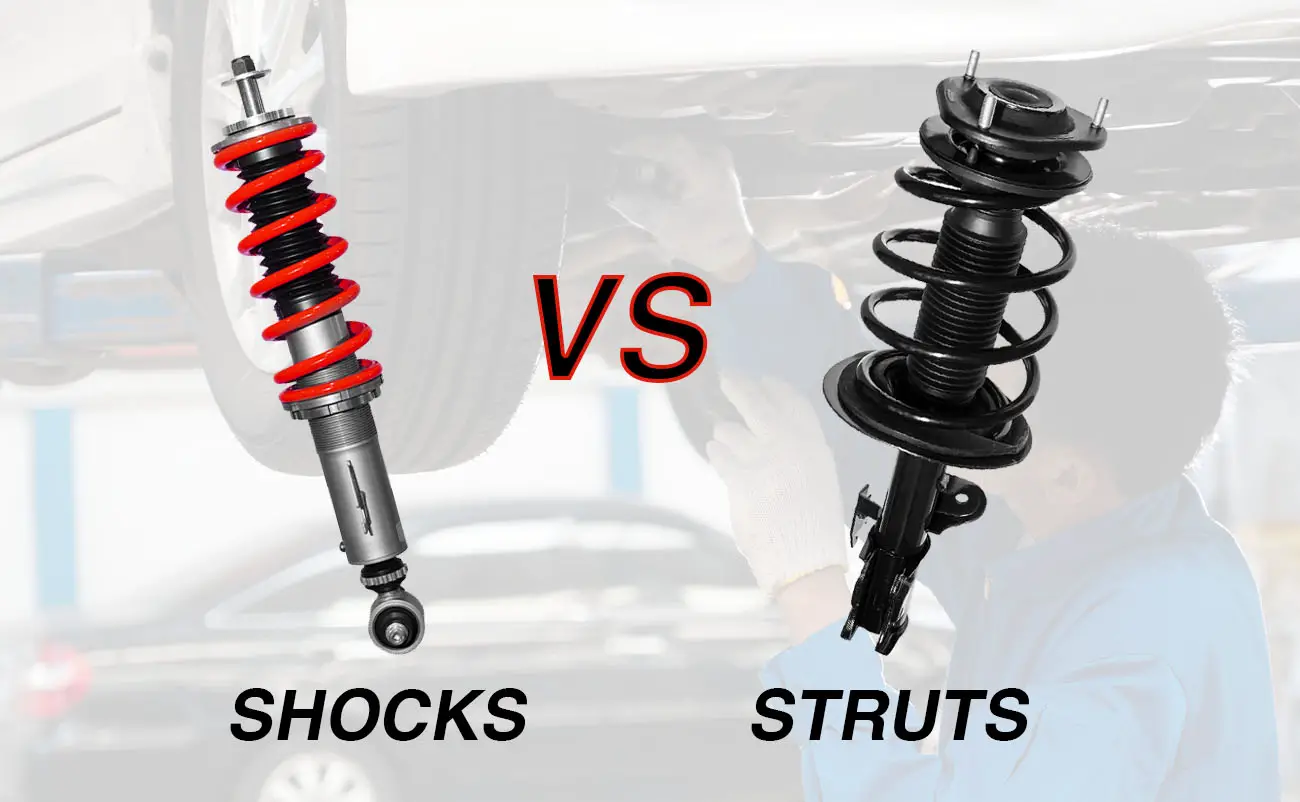Shocks and struts are two of the main components of your car’s suspension system. Both shock absorbers and struts last for a long time under normal use, but they can eventually fail. When they do, you’ll need to get them replaced. Shock and strut replacement cost depend on a few factors, like the type of shocks and strut assemblies on your specific vehicle. Some people also try to avoid labor costs by doing the work on their own. Keep reading as we give you all the details on replacement costs for shocks and struts and tell you how to replace them yourself.
Table of Contents
Average Cost To Replace Shocks And Struts
Replacing shocks and struts is not cheap, and you can expect to pay anywhere from $500 to $1,200 to replace a pair of struts. Replacing shocks is a little less expensive, and you will usually pay anywhere from $350 to $800 for a pair of shocks for a car. Generally, front strut replacement costs are usually higher than rear shock replacement costs. Some vehicles are equipped with struts on the front and shocks on the back; however, some new cars have strut assemblies at all four corners of the vehicles.
Strut assemblies are not cheap, and the cost of the parts is a big reason the job is so expensive. Strut assemblies can cost anywhere from $150 to $400 each. A Toyota or Honda assembly will likely be much cheaper than a BMW or Mercedes assembly. Since you need to replace them in pairs, you must double that cost for the parts alone. Labor costs usually run a few hundred dollars as well. Remember that you might also need to add wheel alignment costs to the total cost of the job. A wheel alignment is always recommended after replacing suspension components, and you will especially need one if front shocks or struts are replaced.
Visiting your local dealership will certainly result in the highest cost for this work. Sometimes, a dealership can cost you more than double the price of an independent repair shop for the same work. Since this repair is pretty costly, you should probably call reputable independent mechanics in your area to get quotes on the job. You might be able to save yourself a lot of money by going this route.
Difference Between Shocks And Struts

You have already learned about the difference in cost to replace shocks and struts, but what is the difference in the shocks and struts themselves? Both shocks and struts are part of your vehicle’s suspension system, and they help reduce vehicle bounce and control excess vehicle body movement. Both shocks and struts act as dampening devices during bumpy road conditions. However, there is one major difference between shocks and struts.
Shocks are merely one individual component of the suspension system, while struts are a structural component of the suspension system. Struts have several different suspension parts integrated into them. Front struts take the place of the dampening device, coil spring, and upper control arm. The bottom of the strut typically connects to the steering knuckle through a ball joint. Struts not only provide dampening, but they also help maintain wheel alignment and bear much of the side load on the suspension as the car drives.
Symptoms Of Bad Shocks & Struts
We have already mentioned the fact that shocks and struts last for a long time, so how can you tell when they need replacement? There are a few symptoms you can watch for that will alert you to failing shocks or struts. Here are the things you should watch out for, and you should get your vehicle to a repair shop if you notice any of these symptoms.
— Car Bounces While Driving
One of the biggest signs that you have bad struts or shocks is a bouncy ride. Both shocks and struts act as dampeners, and they help reduce vehicle bounce as you drive. The damping function is performed by a hydraulic piston. Worn shocks or struts lose their damping ability, and the car will begin to bounce more as you drive. You might notice that you hit a pothole, and the vehicle continues to bounce long after you drive over it. This is a surefire sign that your shocks or struts are going bad.
— Leaking Fluid
Shocks and struts are closed hydraulic systems, and the hydraulic fluid inside the piston should always stay there. If fluid starts to leak out, then the shock absorber will no longer function properly. Sometimes, a shock absorber can burst and leak fluid immediately. However, you will usually see a more gradual leak. If you notice the sides of your shocks starting to become oily or greasy, then the fluid is probably leaking. In this case, you will need new shocks as the performance of your old shocks will continue to decrease.
— Car Pulls To One Side
Typically, your car pulls to one side when you have a bad wheel alignment. Shocks do not have much of an effect on wheel alignment, but struts play a big role in wheel alignment. A bad strut can throw off your alignment and cause the vehicle to pull to one side. In this case, you could have damage to the strut beyond just the damping piston. The entire strut assembly might need to be replaced. If you experience this condition, you will probably see uneven tire wear as well.
— Vibrating Steering Wheel
Shocks and struts help to dampen the bounce in your vehicle, and they also absorb vibrations as you drive. When these parts go bad, the vibrations in your car will resonate to other parts. You can often feel vibrations in the steering wheel as you drive if the shocks are not working properly. Vibrations in the steering wheel can also point to other suspension problems, so you might need the help of a mechanic to diagnose the specific cause. Just know that these vibrations might point to bad shocks.
— Car Nose Dives When Braking
When you apply the brakes in your car, the momentum of the vehicle still attempts to push the car forward. This momentum causes the front of the car to get lower while the rear of the vehicle rises. During hard braking events, this process is even more noticeable. Your struts and shocks help keep the vehicle from nose diving too much when you apply the brakes. If your front shocks are starting to fail, you might notice a big nosedive when you hit the brakes. This can become dangerous, so you should consider a shock replacement soon if you are experiencing this problem. On the other hand, if your car shakes when braking, you could have warped brake rotors or a braking system problem.
— Car Squats When Accelerating
Similar to a nosedive when braking, bad shocks can also cause the back of your car to squat when accelerating. Not only is this condition annoying, but it results in terrible ride quality and can cause dangerous driving conditions. Your car should maintain a fairly even stance during both acceleration and braking, so a severe squat during acceleration means that your rear shocks need replacing.
— Noises When Going Over Bumps
Some car owners report weird noises when going over bumps. These noises might be a grinding or squeaking sound when bumps are encountered. Usually, these noises signal a problem with a shock or strut. These parts should be mostly silent as the piston rod moves up and down inside the piston. However, noises coming from a shock typically mean that it is failing. It is possible that only the bushings are causing the noise, but usually, weird noises mean that the whole shock is going bad.
When To Replace Shocks And Struts

The lifespan of shocks and struts depends on a couple of factors, like your driving habits, road conditions, and the make and model of your car. Many car owners will never have to replace their shocks as they will not own the car long enough for the shocks to go bad. Average shocks last anywhere from 60,000 to 100,000 miles. Struts typically have a similar lifespan.
Your driving conditions can greatly affect the lifespan of both shocks and struts. If you drive carefully over bumps and potholes, you will likely extend the life of these parts. However, if you drive on rough roads and speed over bumps, then your shocks and struts will wear out more quickly.
You should perform a checkup on your shocks about every 10,000 miles starting at the 60,000-mile mark. Visually inspect the shocks and struts for leaks or signs of damage. If you notice oil or fluid on the shock, then it is leaking and should be replaced. Also, keep an eye out for any of the other symptoms mentioned in the previous section, like a bouncy ride or nosedive when braking.
As long as you are not having any problems with your shocks, there is really no need to proactively replace them. You do not need to perform a shock replacement until your old shocks fail.
How To Replace Shocks & Struts On Your Own
While some people can perform many auto repairs on their own, shock and strut replacement is not an easy task. Replacing these parts often requires some specialized tools, like a spring compressor, that most people do not have. Trying to do the job without these tools can result in damage to your vehicle as well as injury to yourself. If you still wish to proceed, here are the steps you must take.
Replacing shocks is not extremely difficult, and replacing strut assemblies can be done on your own if the spring is part of the assembly. However, if the spring is separate, you should let a professional mechanic handle things to avoid any potential injuries.
First, you will need to support the car on jack stands to raise the tires off the ground. Remove the wheel to gain access to the shock. Spray the top and bottom shock bolts with penetrating oil because these bolts can often be very difficult to remove. Loosen the nut on the bottom bolt, but do not remove the bolt yet. Loosen the nut on the top shock bolt and remove the bolt. Then tap out the bottom bolt with a rubber mallet.
Once the bottom bolt has been removed, you should be able to pull the shock completely out. Reinstall the new shock by replacing the bottom bolt and starting the nut on the bolt. Put the top bolts in place and then tighten all the nuts to the proper torque specs. Repeat the process for each shock that needs to be replaced. Replacing front shocks or struts is sometimes a little more difficult, as you might have other parts in the way, like the tie rods or sway bar.
The Bottom Line
Replacing shocks and struts is not something you will need to do often, but these suspension repair costs could set you back over $1,000 when the time comes. Shocks are typically a little cheaper than struts because shocks are just a single component of the suspension system. Struts, on the other hand, are a structural component of the system and include several subparts. You can save yourself some money by performing the work yourself, but the job can be dangerous due to the high pressure of the springs in the system.
Frequently Asked Questions (FAQs)
Can I replace just my struts or just my shocks without replacing both?
Yes, you can replace your shocks without replacing the struts and vice versa. However, you should always replace them in pairs. For example, both shocks or struts on the front should be replaced at the same time. The same goes for the rear of the vehicle. Some vehicles have front struts and rear shocks, some have front shocks and rear struts, and others have shocks or struts on all four corners. Regardless of the type, both of the front parts should be replaced at the same time, as should both of the back ones.
Should you replace all four struts at once?
You don’t always have to replace all four struts on a car at once. However, they should always be replaced in pairs. Both of the fronts should be done at the same time, and both of the backs should be done at the same time. You typically never want to replace a single strut. This could lead to alignment issues and handling problems while driving.
What are the benefits of replacing all four struts at once?
The benefit of replacing all four struts at once is that your suspension system should function like new again. Replacing them all at once should increase your ride quality, and it should prevent any handling issues. A wheel alignment should also be performed when the struts are replaced. However, know that replacing all four struts at once is not always a requirement. You may choose to replace only the front pair or only the rear pair.
Can I drive with bad struts or shocks?
You can usually still drive with bad struts or shocks. However, you might have problems with the handling of your vehicle. The ride quality will certainly be poor, and you could get into a dangerous situation if the handling is bad enough. You should always replace struts or shocks whenever they fail.


My 2016 caddy has 100,000 miles and front shocks structs need replacing. Local mechanic shop very reliable, built 2 racing vechicles, one truck and car .
I thought of ordering parts ACDelco , original GM parts.
caddy dealer ridiculously expensive.
Would appreciate your opinion. Thank you Bryan Owens